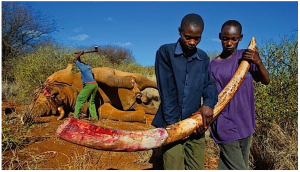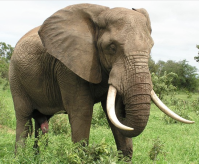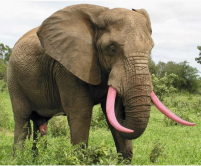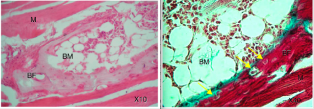What if we could make the tusks on living elephants worthless to humans without the elephants noticing anything?
Prelude
Elephant poaching is reaching dangerous levels again. [Poaching is still at unsustainable levels 2.5 years later. 2014 poaching levels were the same as 2013’s. 14 July 2015.]
Current strategies for fighting it are distressingly and predictably ineffective. There are lots of reasons. The global scale of the strategies needed to be effective is overwhelming. The requisite cooperation among too many uneasy allies is too hard to maintain.
The New York Times had a couple of stories recently. Dec 27 and Dec 30, 2012 The National Geographic had a cover story in the Fall of 2012. [On Mar 19, 2013, the Guardian reported the killing of 86 elephants in Chad.]
We try to keep the poachers from the elephants. Because that is so difficult, we also try to police the traffic in tusks at the borders and to monitor the trade in ivory all around the world.
Illegal tusks are identical to legal tusks. That is the root of the difficulty. The further the poached tusks are from the dead elephant, the harder illegality is to establish. Even poached tusks that are confiscated and stored away are pilfered and sold.
Ivory will always be valuable. Our love of it is ancient and universal. Tangible, immediate greed and deep-rooted covetousness of individuals always trump an irresolute wish to do good by the rest of us.
Being human is a problem, too. I’m not sure I could hold an exquisitely worked piece of ivory in an elegant showroom and muster much outrage at the thought of what hacking butchery might – or might not – have been committed to procure the raw material in a place far far away. It’s easy to think: what’s done is done, but, at least, here’s something beautiful that’s come of it.
OK, that’s the prelude to the question at hand:
The Question
Can the tusks of living elephants be stained to make them visibly illegal?
Stained by means of an orally taken dye “treat” that does not require the elephant to be knocked out or harmed in any way.
Stained in a way that does not affect the tusks’ utility to the elephant or the behavior of elephants to each other.
Stained so that poachers will spare an elephant because they can see that the tusks are “illegal” (and thus of much less or no value to anyone.)
Stained to give any resulting ivory a depreciating ugliness or stigma (or both) so that no one is willing to pay luxury prices to wear or display it openly.
Stained subtly enough to allay the ethical concerns of citizens and activists as well as the concerns of legitimate wildlife interests such as science and tourism.
Stained to leave the elephants oblivious and yet destroy the value of their tusks to humans.
Here’s the letdown: I don’t know the answers. I’m an American Midwesterner without the training to take this anywhere. My local zoo doesn’t even have elephants.
The idea is certainly humorous and absurdist. It was indeed a cartoon of a cavorting elephant with painted tusks that sparked the idea, but what if a color and a means of staining could be found that could pull this off? Suddenly, saving the elephants becomes manageable. The global scale is dispensed with. The focus is solely, simply the elephants. Even the movements of poacher gangs is irrelevant.
The gullible, loveable layman in me says there’s something about the chemical and structural makeup of tusks that makes the idea seem possible. Tusks are highly permeable and “their healing ability following traumatic injury is enormous.” The chemical staining of bone and teeth, in vivo (that is, still inside the patient), is well developed, but on the microscopic level and is not meant to be permanent. Yet, is the stain impermanent and the scale microscopic because that’s all we can do or because no one’s ever wanted a permanently tinted tibial plateau?
So, I put the idea out there for the right people to find it, come together and run with it. Maybe a chemist, a broadminded histologist, some iconoclastic elephant vets, a few diplomats. . .
In other words, the idea’s out there for capable people to do the real work of figuring out what stain, how to apply it and the logistics of a program to make it happen.
Some Facts
What follows are some basic facts about elephants and their tusks as well as some more thoughts on what the stain should do and some concerns about how a staining program might make the problem worse.
Tusks in brief:
Most of the tusk is ivory. Thus, stain the tusk and you’ve stained the ivory. It’s a substance called dentin, of which human teeth are also made. Human dentin is normally covered by enamel. In elephants, the enamel wears away and by maturity, the dentin is largely exposed.
Tusks grow about 7 in (16 cm) a year for most of an elephant’s life. Tusks can reach 11 ft (3.5 m) and can weigh up to 440 pds (200 kg) a pair. Reference here is to the savanna elephant of southern and eastern Africa.
A third of a tusk’s length is unseen inside the head. It is strapped into a deep recess

Brent Stirton, Getty Images/National Geographic
of the jaw to accommodate tremendous cantilevering force on the exposed portion. The oft-suggested remedy of simply chopping off all the elephants’ tusks is thus a non-starter. As the bloody portion of the tusk in the photograph illustrates, there’s still 1/3 of the tusk to poach. An elephant who had the exposed part of his or her tusk cut off, would be more vulnerable to life in the wild as well as to poachers after that last third.
Dye Considerations
Color choice must leave the colorblind elephant oblivious. After assuring that any dye used – and its method of delivery – does not damage the tusk or, in any way, imperil the elephant, the main consideration is the color. The appearance of an elephant’s tusks including their color may play a role in the interactions between elephants. Elephants are apparently colorblind. They can see mainly blue and yellow as well as black, grey and white. With the right hue and value, the tusks’ new coloring may not disturb the elephant or other elephants.
The stain must be indelible. Some clever ivory expert can’t be able to neutralize or wash out the stain with chemicals or other dyes.
The stain must be visible to the naked eye. Invisible dyes such as those that are only apparent under certain lights or using special equipment might be less controversial. However, even if that equipment is cheap and readily available, invisible staining may not stop poaching. Illegal tusks and ivory would still look the same as the legal. As long as poachers had doubts or were confused, I expect that elephants would be shot first and the tusks analyzed later. Currently, ivory of uncertain origin still has an active market. Chances are that invisibly stained tusks would develop their own market.
The stain must penetrate all through the dentin of the tusk. Poachers and buyers have to know that no part of a stained tusk is “salvageable.” The stain cannot be locally applied. If a poacher knows that a third of the tusk hidden in the skull is unmarked, the tusk is still worth poaching. The price of ivory might well rise. The number of tusks would remain constant but only the 1/3 that is inside the elephant’s skull would be of value. In short, you would have reduced the supply of ivory by 2/3s but kept the availability constant. All the elephants would still be at risk.
Ideally, the stain would not be seen in its full intensity on the surface of the tusk. It’d be intense enough to warn off poachers, but not anger locals as well as scientists, tourists or activists. Perhaps, the sun would fade the outer few millimeters.
The stain must also stain new tusk growth. The Holy Grail would be a stain that continues to color new dentin growth. It would be analogous to the persistence of a tattoo in the dermis skin layer. Otherwise, every 5 or 6 years, a dye line will appear at the base of the tusk, alerting poachers that 1/3 of the tusk is unmarked and worth killing for. A dye line may also be disturbing to the elephant despite his colorblindness.
A staining program, of course, has to be on-going to stain the tusks of newly maturing elephants, but the re-staining part would be a more complicated task. Re-staining only when a dye line is visible puts the re-stainers in competition with poachers. Trying to check any other way would require a more invasive, expensive effort. The University of Washington’s elephant DNA databank might make identifying individual elephants and their staining history simpler.
A staining program would need to be instituted quickly and intensively. As a program ramped up, the price of unstained tusks would rise to the degree that poachers judge their supply to be threatened. Though much narrower in scope than current anti-poaching efforts, a tusk staining program would still be fraught with the same political unpredictability. If a staining program were incompletely, unevenly or slowly implemented, it may well end up leaving elephants more vulnerable as the increasing bounty on their tusks and the poachers’ fear of the program may ignite more poaching.
Since the shrinking supply of unstained tusks will be driving their price, it makes sense that the supply of removed tusks stored in warehouses be stained only after the tusks of living elephants.
The Hard Part
Pitching the idea is the easy part. Hopefully, others will do the heavy lifting of identifying a stain and delivery method.
____________
the photo is from wallpaper5.com and is used under the creative commons copyright.
 Yahoo Canada ran a “Daily Brew” article a few days ago about staining tusks to stop poaching. The expert quoted, Anne Lambert of the Internat’l Conservation Fund of Canada, says, “Darting and applying dye to elephants would involve a huge cost and stress and risk to elephants.”
Yahoo Canada ran a “Daily Brew” article a few days ago about staining tusks to stop poaching. The expert quoted, Anne Lambert of the Internat’l Conservation Fund of Canada, says, “Darting and applying dye to elephants would involve a huge cost and stress and risk to elephants.”






